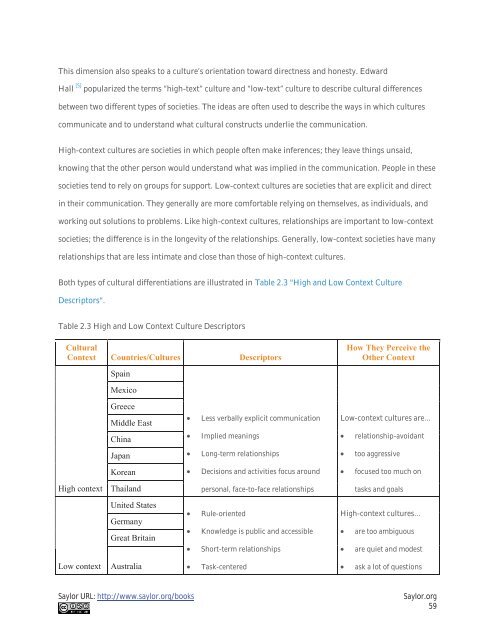Leading with Cultural Intelligence, 2012a
Leading with Cultural Intelligence, 2012a
Leading with Cultural Intelligence, 2012a
Create successful ePaper yourself
Turn your PDF publications into a flip-book with our unique Google optimized e-Paper software.
This dimension also speaks to a culture’s orientation toward directness and honesty. Edward<br />
Hall [5] popularized the terms “high-text” culture and “low-text” culture to describe cultural differences<br />
between two different types of societies. The ideas are often used to describe the ways in which cultures<br />
communicate and to understand what cultural constructs underlie the communication.<br />
High-context cultures are societies in which people often make inferences; they leave things unsaid,<br />
knowing that the other person would understand what was implied in the communication. People in these<br />
societies tend to rely on groups for support. Low-context cultures are societies that are explicit and direct<br />
in their communication. They generally are more comfortable relying on themselves, as individuals, and<br />
working out solutions to problems. Like high-context cultures, relationships are important to low-context<br />
societies; the difference is in the longevity of the relationships. Generally, low-context societies have many<br />
relationships that are less intimate and close than those of high-context cultures.<br />
Both types of cultural differentiations are illustrated in Table 2.3 "High and Low Context Culture<br />
Descriptors".<br />
Table 2.3 High and Low Context Culture Descriptors<br />
<strong>Cultural</strong><br />
Context Countries/Cultures Descriptors<br />
Spain<br />
Mexico<br />
Greece<br />
Middle East<br />
China<br />
Japan<br />
Korean<br />
<br />
<br />
<br />
<br />
Less verbally explicit communication<br />
Implied meanings<br />
Long-term relationships<br />
Decisions and activities focus around<br />
How They Perceive the<br />
Other Context<br />
Low-context cultures are…<br />
<br />
<br />
<br />
relationship-avoidant<br />
too aggressive<br />
focused too much on<br />
High context<br />
Thailand<br />
personal, face-to-face relationships<br />
tasks and goals<br />
United States<br />
Germany<br />
Great Britain<br />
<br />
<br />
<br />
Rule-oriented<br />
Knowledge is public and accessible<br />
Short-term relationships<br />
High-context cultures…<br />
are too ambiguous<br />
are quiet and modest<br />
Low context<br />
Australia<br />
<br />
Task-centered<br />
<br />
ask a lot of questions<br />
Saylor URL: http://www.saylor.org/books<br />
Saylor.org<br />
59


















